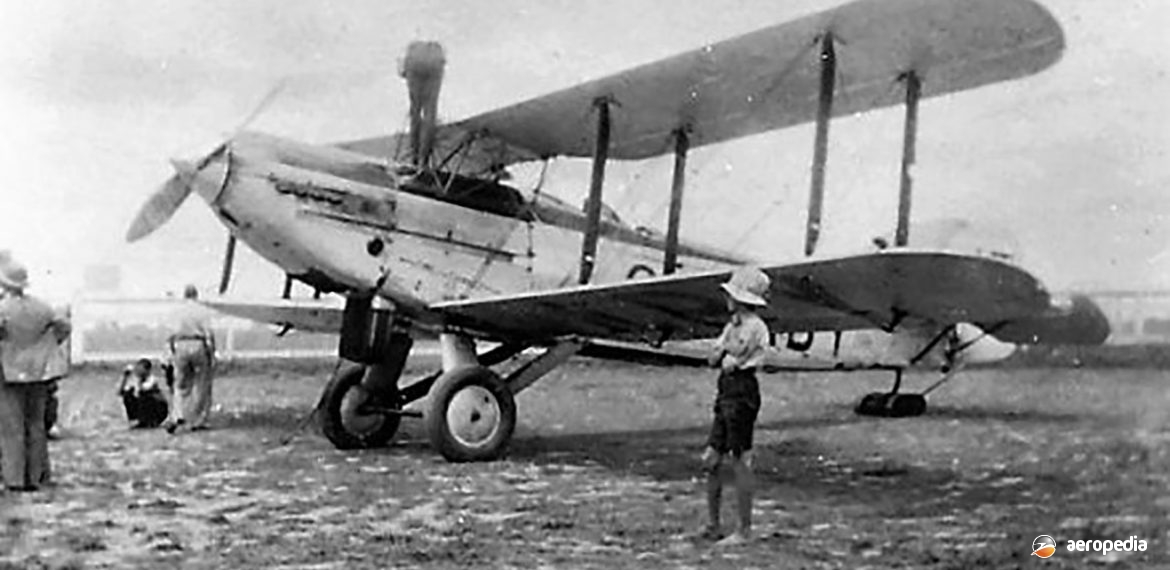Photograph:
Fairey IIIF G-AABY – VH-UTT (c/n F.1129) (Frank Walters collection)
Country of origin:
United Kingdom
Description:
General-purpose reconnaissance biplane
Power Plant:
One 425 kw (570 hp) Napier Lion XIA twelve-cylinder broad-arrow liquid-cooled engine
Specifications:
- Wingspan: 13.99 m (45 ft 9 in)
- Length: 11.21 m (36 ft 8⅝ in)
- Height: 4.25 m (13 aft 11⅜ in)
- Wing area: 40.73 m² (438.5 sq ft)
- Max speed 3,048 m at (10,000 ft): 193 km/h (120 mph)
- Landing speed: 94 km/h (58 mph)
- Climb to 1,524 m (5,000 ft): 6 mins
- Rate of climb: 335 m/min (1,100 ft/min)
- Service ceiling: 5,761 m (18,900 ft)
- Range at cruising speed with 623 litres (136 Imp gals) of fuel: 1,424 km (885 miles)
- Max range with 1,077 litres (237 Imp gals) of fuel: 2,336 km (1,520 miles)
- Empty weight: 1,779 kg (3,923 lb)
- Loaded weight: 3,406 kg (7,510 lb)
Armament:
One 7.7 mm (0.303 in) Vickers machine gun on port side of fuselage; one 7.7 mm (0.303 in) Lewis Mk III machine gun on Scarf ring for observer; two 113 kg (250 lb) or four 51 kg (112 lb) bombs
History:
The Fairey IIIF shared little, apart from a structural similarity, with the Fairey Fox. In 1924 a specification was issued for a three-seat spotter reconnaissance aircraft for the Royal Navy Fleet Air Arm. This led to the development of the Fairey IIID and, although the Napier Lion engine was retained, it was a later model engine enclosed in a streamlined cowling fitted with a Fairey-Reed metal propeller. The flat-sided fuselage was faired to an oval section, the tail surfaces were re-designed, and a V-strut undercarriage capable of withstanding the required rate of descent was fitted.
The prototype Fairey IIIF (N198 – c/n F.574) was first flown at Northolt in London by Captain Norman Macmillan on 19 March 1926, this model having a metal fuselage, wooden wings, and fabric covering. It was ordered in some numbers by the Royal Air Force (RAF). The Fairey IIIF was offered to the RAF as a replacement for the de Havilland DH.9A and a range of batches was produced for a number of operators, a variety of engines being available including the 474 kw (635 hp) Rolls Royce Kestrel II, 343 kw (460 hp) Armstrong Siddeley Jaguar VI radial, the 392 kw (525 hp) Panther IIA, the 388 kw (520 hp) Bristol Jupiter VIII, and the licence-built Junkers Jumo V.205C, known as the Napier Culverin two-stroke diesel. In the 1930s a re-conditioning program was put in place, a lot of the RAF’s Fairey IIIFs being fitted with the Armstrong Siddeley Panther engine and converted to Fairey Gordon standard.
On 1 March 1928 a proposal was made to purchase sixteen Fairey IIIFs to equip the Royal Australian Navy (RAN) cruisers ‘HMAS Canberra’ and ‘HMAS Australia’, and the seaplane tender ‘HMAS Albatross’, the aircraft to be suitable for catapulting and to carry a crew of three. They were to be placed in service pending the development of a new amphibious aircraft, the latter later becoming the Supermarine Seagull V. The purchase was approved with the cost of $13,000 (£6,500) to come out of the Naval Construction Vote but funds were withdrawn and no aircraft were obtained.
One Fairey IIIF Mk IVM was placed on the Australian civil register. This aircraft VH-UTT (c/n F.1129 – ex G-AABY) was flown by Flying Officer C G Davies with Lieutenant Commander Hill as navigator in the 1934 MacRobertson Air Race, the aircraft being named ‘Time and Chance’. It arrived in Australia on 24 November 1934 but was not classified as a place getter.
It was then obtained by Major E G Clerk, who arrived in Brisbane, QLD in November 1934 with the intention of conducting aerial joyriding and air-circus operations with two Avro 504Ks (G-EBYW and G-ABWK) and a Spartan Arrow (G-ABJS, later VH-UUU), with the Fairey IIIF as a back-up aircraft at Toowoomba, QLD. It was operated by Australian Air Services, the company of Major E G Clerk. During that time it was sold to Major Clerk and operated until April 1936 when the registration lapsed.
In the event in August 1936 the aircraft was sold to Raymond Parer for operations by Papuan Air Transport Services (PAT) from Wau in Papua New Guinea, the aircraft commencing operations in Salamaua. Because Davies became ill and could not fly the aircraft to New Guinea. it was flown by Parer, who was manager of PATS, with J Thompson, arriving at Wau on 21 April 1935. The aircraft was written off on or about 24 August 1937 in the Sepik area, the Certificate of Registration lapsing on 12 March 1936, and the aircraft was broken up.
Three Fairey IIIFs were obtained for the RNZAF, two purchased in 1929 and a replacement (S.1805) in 1933. This latter aircraft retained its RAF serial during its New Zealand service and was strengthened as a Fairey IIIF Mk IIIB catapult variant. It operated up until 1939 on both floats and wheels on naval co-operation duties and was then withdrawn from service. It became an Instructional Airframe at Hobsonville Technical Training Centre. It is believed to have been broken up late in World War II.
The other two Fairey IIIFs for the RNZAF (serials and c/ns F.1133 and F.1134) arrived in Auckland in September 1929 on board the freighter ‘Port Melbourne’ and, after assembly, operated as landplanes, although seaplane floats were available. F.1134 crashed at Birkdale 12 months after delivery, F.1133 continuing in service until later in the war when it became an Instructional Airframe and was later broken up.

